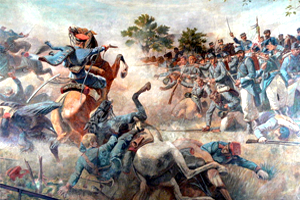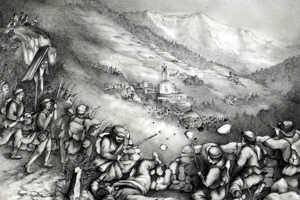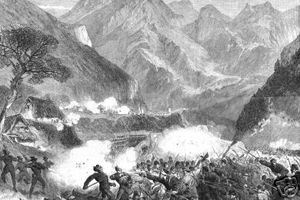At the same time the Austrian troops, nearly 1000 men under the command of von Albertini, were between Ponte di Legno and Stadolina. The evening of that same day Castellini met Caldesi at Incudine. It remains unclear if Caldesi, who was in poor health, mentioned Caldolini’s order to withdraw in case of an enemy attack. Castellini assumed that he should hold the positions previously occupied at Vezza d’Oglio and Grano. During the night beween 3 and 4 July the Austrians began moving towards Vezza in four columns: the first in the direction of San Clemente, the second in the direction of Carona, the third in the direction of San Sebastiano and the fourth along the left bank of the Oglio. Having spotted enemy troops, Captain Malagrida, following the orders received from Caldesi, ordered the company and a half deployed at Vezza and Grano to retreat to Incudine. This did not prevent the Austrians from surprising and taking prisoners some volunteers who had stayed behind near the cemetery. During the withdrawal Malagrida encountered a patrol of Bersaglieri on reconnaissance under the command of Giulio Adamoli, who brought him to Castellini in Davena to whom he explained he had obeyed Caldesi’s order to retreat. Convinced that it was a misunderstanding, Castellini persuaded Malagrida to retrace his steps, launch a counterattack with the entire 2nd Battalion of Volunteer Bersaglieri, and to reoccupy the positions they had abandoned.
In the meantime, however, the Austrians had occupied Vezza entirely, positioning four cannons on the castle and entrenching themselves behind buildings and garden walls. The Italians advanced on three fronts: upstream towards Grano, now also occupied by the Austrians, centrally towards Vezza, and in the valley along the right bank of the Oglio. Having arrived in the proximity of the first houses they were greeted by heavy burst of gunfire by the well-positioned enemy. The first officer to fall was the Second Lieutenant Achille Prada of the Volunteers, while next to him Captain Giulio Adamoli of the Bersaglieri was wounded, though without severe consequences. Having run out of ammunition, Adamoli ordered a bayonet assault, but the intense enemy fire rendered the advance impossible and the Italians were forced to retreat with severe losses. In the meantime, in the audacious attempt to take the Austrian cannons at the castle, Major Castellini placed himself at the head of his Bersaglieri but, hit several times, fell mortally injured near the Santella di San Carlo. Some of the volunteers carried him in their arms to Incudine, but futilely.
Despite this, the Italian attack continued under the guide of Captain Antonio Oliva who, as the oldest officer, replaced Castellini as the commander of the Bersaglieri. In one of the last attacks Captain Antonio Frigerio, commander of the 3rd Company of Bersaglieri, was also injured and later died from bleeding during his transport down the valley. Around eight in the morning the Austrians began to advance on the left bank of the Oglio, where they met no resistance, and hence threatened to encircle the entire Italian formation. Thus, seeing the useless attempts to reconquer Vezza and the danger looming on the right wing, the order came to retreat to Incundine, which the Italian volunteers carried out efficiently with most of the wounded in following.
The fighting was over. Twenty Italians had died: fifteen Bersaglieri, among whom Commander Nicostrato Castellini and Captain Antonio Frigerio, and five Garibaldini volunteers, among whom Second Lieutenant Achille Prada. The Austrians had suffered five casualties. The wounded were seventy among the Italians, seventeen among the Austrians. Moreover, seventeen Italian prisoners, most of them wounded, remained in Austrian hands. Despite the failure, the Bersaglieri and Volunteers had fought well and courageously, earning the praise even of their adversaries. The rest of the 1st Volunteer Battalion, under the command of Caldesi, did not take part in the fighting, remaining instead entrenched in front of Incudine in accordance with the orders received from the commander of the Regiment, Cadolini. Caldesi, however, ordered the two cannons deployed at Salto del Lupo to fire a few shots, but to little effect.
At the end of the day on 4 July the Austrians pushed forward to Davena, left unoccupied by the Italians, but then retreated to Vezza and finally to the Passo del Tonale, bringing with them their fallen and the Italian prisoners who were able to move. Instead, the most seriously wounded Italians were brought to the parish church and, as the Austrians withdrew, were left in the care of the local population. Among the most distinguished of these locals were Mayor Martino Pasolini, municipal doctor Antonio Bertoletti, municipal veterinarian Lorenzo Tedeschi, the municipal assessors, and the cleric. The work done by Mrs Caterina Boniotti Ventura is worthy of particular mention, as testified by the tricolor scarf later donated to her by the Trentine veterans. The fallen Italian soldiers were buried with military honors by the Austrians in the cemetery of Vezza, where some of them still rest in the Charnel House erected in 1895. On 5 July the Italian Volunteers, under the command of Lieutenant Colonel Cadolini, reoccupied Vezza d’Oglio and sent the wounded and the remains of Captain Frigerio back to Edolo. However, on 15 July the Volunteer units retreated from the upper part of the Valle Camonica, leaving behind only the National Guard with a few Finanzieri and Carabinieri. This allowed the Austrians to descend once again into the valley all the way to Edolo on 20 July and again to Vezza on 23 July, where numerous requisitions took place, before they retired definitively back to the Tonale.
It is worthwhile to underline the great display of solidarity of the population of Vezza d’Oglio towards the wounded and the other Italian volunteers despite the severe damages inflicted by the Austrians with their confiscations of goods, means of transport, livestock, and the loss of the harvest. The war ended on 12 August 1866 with the defeat of the Austrians, mainly due to the outcome of the battle of Sadowa against the Prussian army. The Italian soldiers made prisoners at Vezza were transfered to Vienna and then Croatia, and were finally repatriated at Udine at the end of the war.




